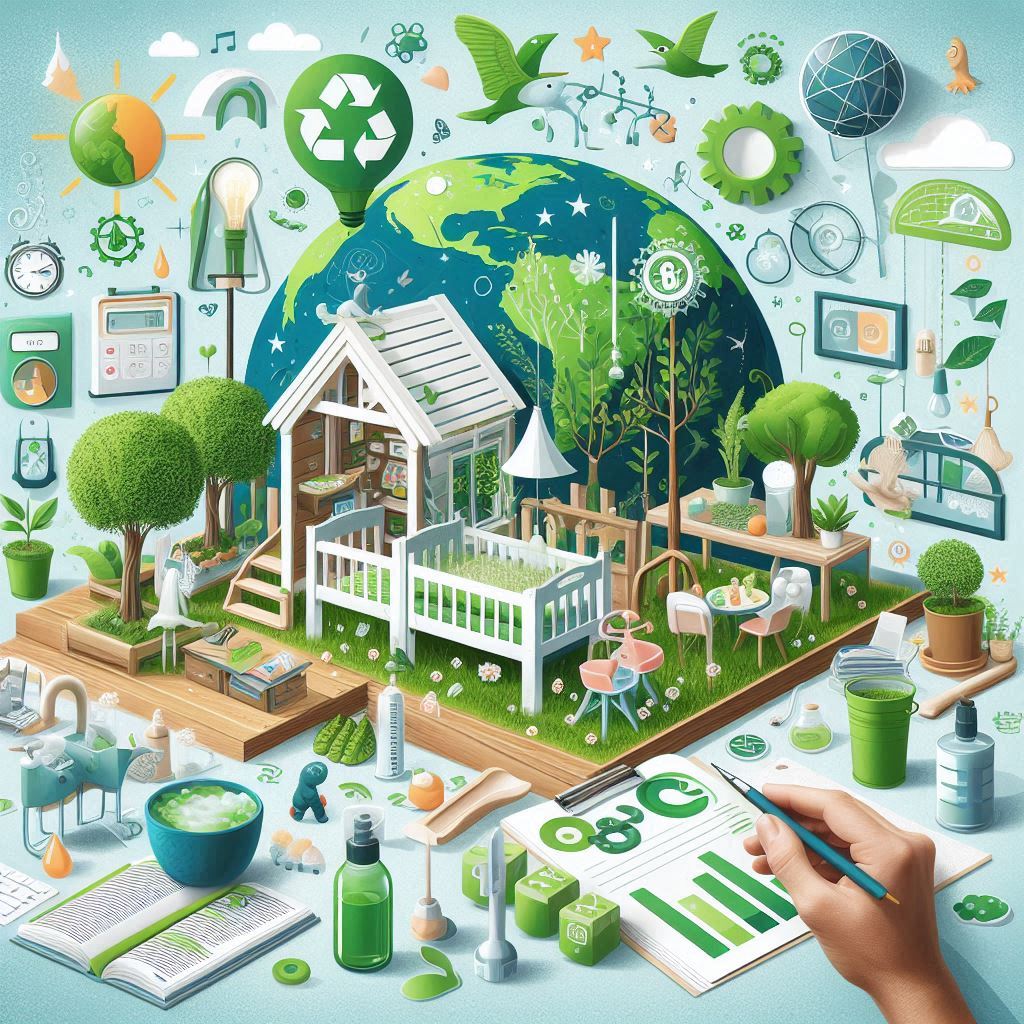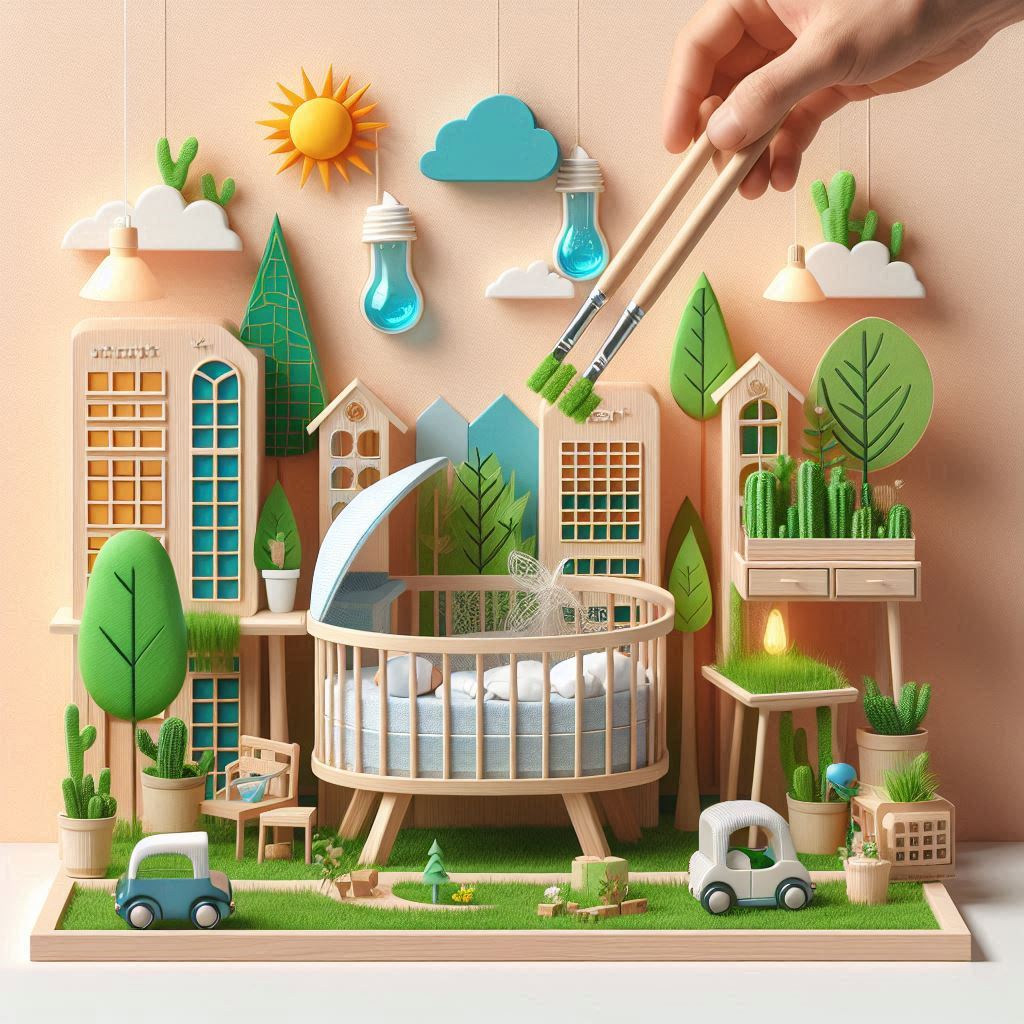Preparing for the arrival of a baby is an exciting time for any parent. One of the most important tasks is setting up a nursery that is not only comfortable and safe but also environmentally friendly. Many people assume that going green means spending more, but the truth is you can create an eco-friendly nursery on a budget with some thoughtful planning and creative choices.
In this blog post, we’ll guide you through the steps to designing a sustainable, toxin-free, and eco-friendly nursery without breaking the bank. Whether you’re a first-time parent or just looking for ways to reduce your environmental impact, these tips will help you create a space that’s as gentle on the planet as it is on your baby.
1. Why Choose an Eco-friendly Nursery?
Before diving into the details, it’s important to understand the benefits of creating an eco-friendly nursery. Babies spend a lot of time in their nurseries, and the quality of the environment impacts their health and development.

Key Reasons to Choose an Eco-friendly Nursery:
- Health Benefits: Eco-friendly materials like organic cotton and non-toxic paints help reduce your baby’s exposure to harmful chemicals, improving indoor air quality and reducing risks of allergies or respiratory issues.
- Sustainability: By choosing sustainable materials and practices, you are reducing the overall environmental footprint of your nursery.
- Cost Savings: Many eco-friendly choices, such as buying second-hand furniture or energy-efficient appliances, can save you money both in the short and long term.
Pro Tip:
Going green doesn’t have to mean going over budget. Many eco-friendly products are cost-effective, especially if you buy second-hand or repurpose existing items.
2. Eco-friendly Nursery Basics
1. Choose Non-toxic Paint and Wall Decor
One of the easiest ways to make your nursery eco-friendly is by using non-toxic paint. Traditional paints often contain volatile organic compounds (VOCs), which release harmful chemicals into the air. Instead, choose low-VOC or zero-VOC paints that are safe for both you and your baby.
- Eco-Benefit: Reduces indoor air pollution and limits chemical exposure.
- Pro Tip: Look for paints certified by eco-labels like GreenGuard or EcoLogo to ensure they meet strict environmental and health standards.
2. Opt for Second-hand or Repurposed Furniture
Nursery furniture can be expensive, but there’s no need to buy everything brand new. Instead, consider buying second-hand cribs, dressers, and rocking chairs from local thrift stores, online marketplaces, or even family and friends. Repurposing furniture that you already own is also a great way to save money and reduce waste.
- Eco-Benefit: Reusing furniture minimizes the demand for new resources and reduces landfill waste.
- Pro Tip: Make sure any second-hand crib meets current safety standards and hasn’t been recalled.
3. Invest in Organic Bedding and Mattresses
Your baby will spend a lot of time sleeping, so it’s important to choose an organic crib mattress and bedding made from natural materials like organic cotton or bamboo. Conventional mattresses can contain harmful flame retardants and chemicals, while organic options are safer for your baby’s skin and lungs.
- Eco-Benefit: Organic materials are produced without toxic chemicals and are biodegradable.
- Pro Tip: Look for a crib mattress that’s certified by GOTS (Global Organic Textile Standard) or OEKO-TEX to ensure it meets strict environmental and health standards.
3. How to Make an Eco-friendly Nursery on a Budget
Creating a sustainable nursery doesn’t have to be costly. With a bit of creativity and planning, you can find eco-friendly options that are affordable and stylish.
1. Buy Second-hand and Thrift Items
One of the most budget-friendly ways to create an eco-friendly nursery is to buy second-hand items. This reduces the demand for new products, saves money, and keeps perfectly good items out of landfills. Check local thrift stores, online marketplaces like Facebook Marketplace, and neighborhood yard sales for great deals on cribs, dressers, and other nursery essentials.
2. DIY Decor and Accessories
Instead of buying expensive new nursery decor, try your hand at some DIY projects. You can make your own wall art, mobiles, and even storage baskets using sustainable or recycled materials.
- Pro Tip: Use leftover fabric to create cute wall hangings, or repurpose an old blanket as a throw rug.
3. Use Multi-purpose Furniture
When space and budget are tight, opt for multi-purpose furniture. For example, choose a dresser that can double as a changing table, or a crib that converts into a toddler bed. This will save both money and space in the long run.
- Eco-Benefit: Reduces the need to purchase new items as your baby grows.
- Pro Tip: Look for convertible cribs and modular furniture that can adapt to your child’s changing needs.
4. Minimize Plastics and Choose Sustainable Materials
Avoid buying plastic items that can off-gas harmful chemicals. Instead, choose nursery products made from sustainable materials such as wood, organic cotton, wool, and bamboo. Wooden toys, wool rugs, and cotton storage bins are all eco-friendly alternatives to their plastic counterparts.
- Eco-Benefit: Reduces plastic pollution and supports renewable resources.
- Pro Tip: Opt for toys made from sustainably harvested wood or recycled materials.
5. Energy-saving Lighting and Appliances
It’s easy to make your nursery more energy-efficient by choosing LED light bulbs and Energy Star-rated appliances like air purifiers and humidifiers. These products use less energy and save you money on your utility bills.
- Eco-Benefit: Reduces energy consumption and lowers greenhouse gas emissions.
- Pro Tip: Choose a dimmable LED light for nighttime feedings or diaper changes, which uses less electricity and creates a calming atmosphere.
4. Eco-friendly Nursery Checklist

Here’s a quick checklist to help you plan your eco-friendly nursery on a budget:
| Item | Eco-friendly Alternative |
|---|---|
| Paint | Low-VOC or zero-VOC paint |
| Crib | Second-hand crib or eco-friendly crib made from sustainable materials |
| Mattress | Organic crib mattress (GOTS-certified or OEKO-TEX certified) |
| Bedding | Organic cotton or bamboo crib sheets |
| Changing table | Multi-purpose dresser with changing pad |
| Lighting | LED bulbs or energy-efficient lamps |
| Decor | DIY wall art, mobiles, and accessories |
| Storage | Wooden or fabric storage bins, second-hand shelving |
| Toys | Wooden or recycled material toys |
| Air Purifier/Humidifier | Energy Star-rated, non-toxic materials |
Pro Tip:
Plan out your nursery in advance so you can keep an eye out for second-hand or sales on the items you need. Being flexible with your purchases allows you to find eco-friendly bargains.
5. FAQs About Creating an Eco-friendly Nursery on a Budget
Q1: How can I create an eco-friendly nursery without spending a lot?
You can save money by focusing on second-hand items, DIY projects, and multifunctional furniture. Look for used furniture in good condition, and repurpose existing household items where possible. Opting for minimalism and buying only what you need will also keep costs down.
Q2: Are second-hand baby items safe?
Yes, second-hand items like cribs, dressers, and rocking chairs can be safe as long as they meet current safety standards. Always check for recalls, inspect items for damage, and thoroughly clean them before use.
Q3: What’s the most affordable way to make my nursery eco-friendly?
Start by swapping out items you already have with eco-friendly versions when it’s time to replace them. Thrifting, using second-hand furniture, and DIYing decor are some of the most budget-friendly ways to create a sustainable nursery.
Q4: How can I tell if a product is truly eco-friendly?
Look for certifications such as GOTS for textiles, GreenGuard Gold for low emissions, and OEKO-TEX for non-toxic products. These labels ensure that products meet environmental and health standards.
Q5: Can I still use plastic items in an eco-friendly nursery?
While it’s best to minimize plastic, some plastic items are durable and long-lasting, meaning you don’t have to throw them out immediately. If you already have plastic baby products, use them as long as possible to avoid waste. When it’s time to replace them, look for alternatives made from sustainable materials.
Conclusion
Creating an eco-friendly nursery on a budget is not only possible, but it can also be a fun and rewarding experience. By making smart choices—like buying second-hand, opting for non-toxic materials, and rethinking how you use everyday items—you can reduce your environmental impact while keeping costs low.
Remember, you don’t need to make every change at once. Start with a few eco-friendly swaps and build your nursery over time. With a little creativity and thoughtfulness, you’ll be able to create a beautiful, safe, and sustainable space for your baby to grow.

0 Comments